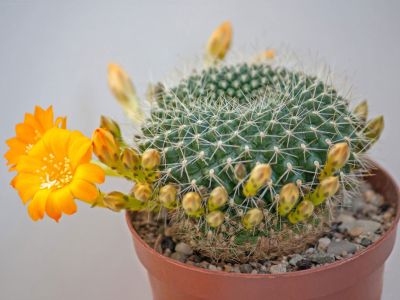Several types flower profusely from the rounded domes, as does the Krainz crown cactus. It is one of the earliest to bloom and has a continuous flowering cycle, making them long-lasting. Blooms are brightly colored in oranges and yellows.
Growing a Crown Cactus
If you grow crown cacti or are thinking of getting one, you may have questions about the care of crown cactus plants. One point that stands out from crown cactus info is the strict need for yearly repotting during the first few years. Of course, we try to repot all our plants as needed, but it sometimes helps to have it laid out for us. Stems grow larger with more room in a new container and increase in number. Consequently, the plant grows more of its beautiful flowers. A larger container allows clumping offsets room to develop and make the plant look even better. Late winter is the best time to move the cactus to a new pot, but other times of year are okay too. Be prepared with thick gloves before repotting the cactus, as the spines are thin and bristly, making it easy to get pricked. Repot into new, dry soil and wait two to three weeks before watering. This allows time for any broken roots to heal and helps avoid root rot.
Other Care for Rebutia
Water as you do for other cacti, giving limited water in spring and summer and withholding water for fall and winter. When the temperatures in autumn begin to drop, it is time to stop watering the crown cactus until spring. When growing indoors or bringing this plant in for winter, avoid putting it in a spot hit by drafts from doors, windows, or heating vents. Grow it in a bright, shady spot with limited morning sun if possible. Keep it in your coolest room when it is inside during winter. Fertilize Rebutia lightly during the growing season with a low-nitrogen houseplant food at ¼ to ½ strength or use a special cacti fertilizer if you have one. Enjoy your crown cactus during all seasons and try different varieties too. They are all easy to grow with frequent, beautiful flowers.
